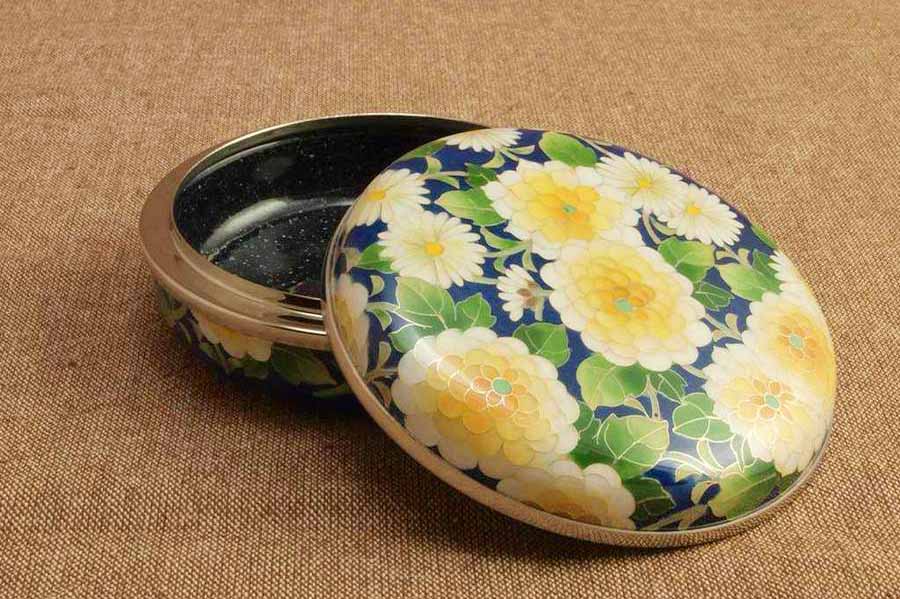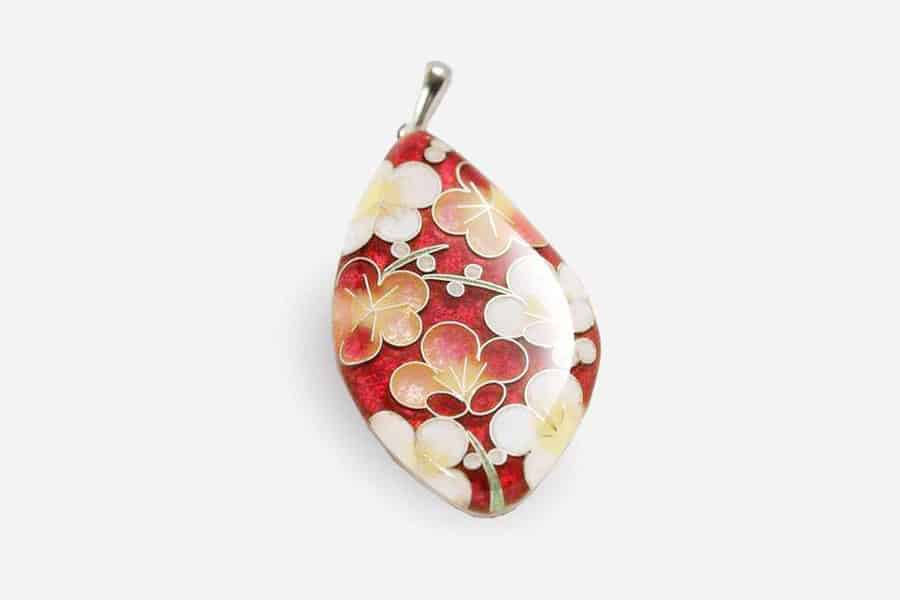Owari Cloisonne wares are characterized by their beautiful decorations featuring flowers, birds, and other motifs, as well as their durableness due to their glass coating. They are also unique for being made from metal, whereas most fired wares are made from clay or stone. In this article, we’ll discuss this traditional Japanese craft hailing from Aichi Prefecture, explaining its history, characteristics, and how it is made.
The History of Owari Cloisonne

“Owari Cloisonne” describes enamelware produced in the cities of Nagoya, Ama, and Kiyosu in Aichi Prefecture. Fired wares are usually made from clay or stone, but Owari Cloisonne is made from silver, copper, and other metals. The metal base is then coated with a glass glaze (not unlike the one used in traditional Japanese pottery) and adorned with colorful decorations. Because of their outer enamel coating, Owari Cloisonne wares are very durable and impervious to mold.
Owari Cloisonne is known as “Owari Shippo” in Japanese, with “shippo” meaning “the seven treasures of Buddhism”: gold, silver, lapis lazuli, crystal, pearl, coral, and agate. The wares are supposed to rival these treasures in beauty.

The art of cloisonne goes back millennia, first originating in ancient Egypt. After being introduced to Europe and China, it finally arrived in Japan around the 7th century. Usually, wares made from clay or stone start out as everyday objects and are later elevated to works of art and traditional crafts. However, from the moment they first arrived in Japan, Owari Cloisonne wares have been considered works of art.

What we now know as Owari Cloisonne can be traced back to the Owari Domain (modern-day Aichi Prefecture) circa 1830 – 1844, when a local craftsman by the name of Kaji Tsunekichi modified a cloisonne plate imported from the Netherlands. The methods that he came up with then helped create the art of Owari Cloisonne, which later became an entire industry. In the late 19th century, the wares were recognized as a specialty product of the Owari Domain.
Owari Cloisonne was presented at the International Exposition of 1867 in Paris where it won an award and became known around the world. The production techniques of these wares have been evolving since the Meiji Period (1868 – 1912), and now various types of Owari Cloisonne exist. In 1995, Owari Cloisonne was designated a traditional Japanese craft by the Ministry of Economy, Trade and Industry.
The Characteristics of Owari Cloisonne

There are many ways to produce an Owari Cloisonne ware, each one producing a different result. These production methods are the same as the ones used to make antique European jewelry. As such, the craft takes a lot of inspiration from European culture and history. Here are a couple of forms Owari Cloisonne can take:
Yusen Shippo – Wired Cloisonne
This technique involves laying down metal wire along the lines of a design sketch, creating a mold which enamel glaze will be poured into.
Musen Shippo – Wireless Cloisonne
This technique is similar to wired cloisonne but here, before the wares are fired, the metal wires are removed and don’t play a role in the decoration process. This results in soft patterns with blurred, unclear borders.
Moriage Shippo – Raised Cloisonne
This technique involves raising the enamel level above the metal wire level, creating a kind of three-dimensional pattern.
Shotai Shippo – Plique-a-jour Cloisonne
This technique is similar to wired cloisonne but here, in the end, the metal wires are dissolved with nitric acid, creating similar designs to those seen in wireless cloisonne.

Owari Cloisonne can be made many different ways, but each one requires a high level of precision and skill, so cloisonne craftspeople tend to be very specialized. Here is how the Yusen Shippo (wire cloisonne) production process looks like:
- Planning: Deciding on the shape and design of the ware.
- Creating the base: Using a wooden or a metal hammer to shape a copper sheet into the base for the ware. Nowadays, this step is usually done with the use of machines.
- Designing: Drawing the design on the metal base with ink.
- Wiring: Laying down wires along the lines of the design.
- Glazing: Pouring enamel into the outline created by the metal wires.
- Firing: Placing the ware in a kiln and firing it at 700℃ – 800℃ for 10 – 15 minutes. This process is repeated until the enamel and the metal base are level. Previously, craftspeople used charcoal furnaces, but nowadays firing is done in electric kilns.
- Polishing: Adding a shine to the finished product.
- Trimming: Finishing the product by attaching a silver or brass rim to its top and bottom.
Owari Cloisonne Today

Today, Owari Cloisonne isn’t just limited to flower vases and pots. It’s also a popular method to make accessories like pendants or earrings. The craft of Owari Cloisonne keeps evolving and developing new techniques, and thanks to its frequent appearances in the media, more and more people learn about it every day.
Related articles:
▶ 7 Japanese Accessories for Any Outfit and Occasion
▶ The Complete Guide to Traditional Japanese Crafts
Featured Products
PENDANT RED PLUM

This pendant is the epitome of modern Owari Cloisonne. The design features red and white plum blossoms, which are considered good luck symbols, covered by delicately transparent “akasuke” red glaze. This makes the pendant look as lovely as a precious stone.
▶ Click here to browse more beautiful OWARI CLOISONNE Pendants
GRAPE WEN MINISTRY OF WOMB CLOISONNE LAMP


This lamp is an example of Shotai Shippo (plique-a-jour cloisonne). The process is identical to that of Yusen Shippo (wired cloisonne) but here, the metal wires are ultimately dissolved. The finished product is highly translucent and delicately beautiful, which requires a lot of skill and experience to pull off. It’s sometimes said that the process is difficult enough to make an experienced artisan cry. The bold design features grape vines and leaves in abundance, which help create a beautiful, otherworldly effect when the light shines through them.
WIRED 3 BALL-SHAPED RED TRANSPARENT PLUM

This small vase, which you may recognize from the beginning of this article, features a plum blossom design which dates back to the Meiji Period and is one of the most famous Owari Cloisonne patterns in history. The "3 ball" in the name refers to the size of the vase. At 9 cm tall, it just equals the height of three balls stacked on each other. Its small size only accentuates the skills of the craftspeople who managed to get such elaborate patterns on such a limited surface.
▶ Click here to browse more beautiful Owari Cloisonne items
If you want to give feedback on any of our articles, you have an idea that you'd really like to see come to life, or you just have a question on Japan, hit us up on our Facebook, Twitter, or Instagram!
*These products may not be able to be shipped to certain countries. Please see the retailer's website for more information.
The information in this article is accurate at the time of publication.
